Dry Dredgers Field Trip
May 27, 2017
Ponderosa Ranch, Ohio
Bellevue
Formation
Photos by Bill Heimbrock
We gathered at a rest stop in large numbers for an opportunity
to go to the famous Mount Orab trilobite farm to collect unprecedented numbers
of Flexicalymene and Isotelus trilobites.

Bob
Bross, our field trip chair, arrived early to check out the site. We had lots
and lots of rain in May 2017, as well as the night before the field trip. We
didn't know whether the site would be flooded. Bob returned with a sad face and
unfortunately, it would be impossible because it was impassable.
Fortunately, fossil hunting in the tristate area is
ubiquitous. We quickly came up with an alternate site, less than a half-hour
away from where we were.
The Ohio site we code named "Ponderosa Ranch" was not flooded.
It had been a popular site in past years for finding the large brachiopods
Vinlandostrophia (Platystrophia)
ponderosa and
Rafinesquina ponderosa. The site exposes the Bellevue
Formation of the Cincinnatian Series. These rocks and fossils are from the Late
Ordovician Period and are about 445 million years old.
This was also not a sure thing because the Ponderosa
Ranch site had been flooded out in the past, as well. Here are some photos
of us hunting brachiopods that day. For most, it was much fun as hunting
trilobites.
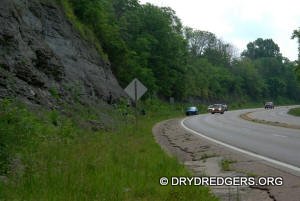

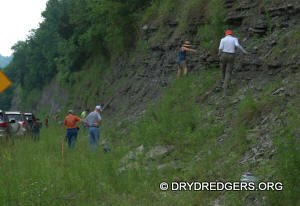

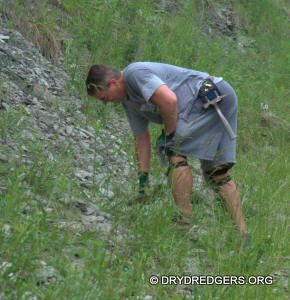

Fossils Found That Day
Best Find of the Day
Trilobites were still the theme of the day, even at our
brachiopod site. The best find of the day was made by a family of fossil fans
who were examining the ground after spotting some trilobite fragments. They
found an impressive spiny trilobite called
Acidaspis cincinnatiensis! Awesome! Congratulations.

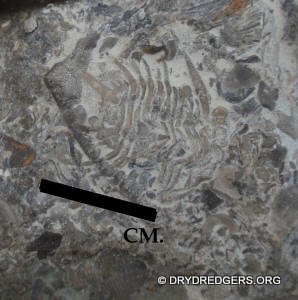
As you can see from the photo below, this
Acidaspis cincinnatiensis trilobite specimen is small and hard to
see but really a decent size specimen.
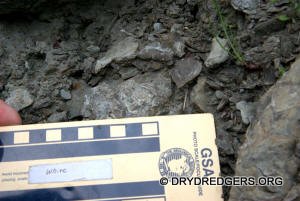
What we really wanted to find was a complete specimen of the
very large trilobite Isotelus sp.
But one member did find a very nice fragment. Shown below, this is the underside
of an Isotelus sp. trilobite and remarkably, it has
the Hypostome (mouth place) in place! This is probably the second best find of
the day.
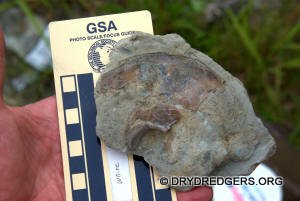
And someone did find a somewhat decent prone and potentially
complete Flexicalymene sp.
just waiting to be "prepped out" of the matrix.
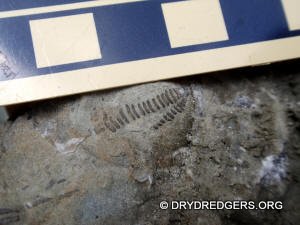
There were at least a couple of nearly complete Flexicalymene
sp. trilobites found. These were inverted, meaning we are looking at the
underside of the trilobite in the Ordovician mud.
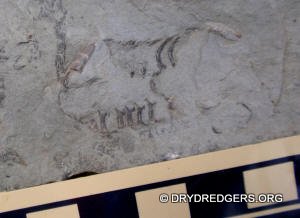

Here are a couple of pygidia (tails) of
Flexicalymene sp. trilobites people found.


Trilobite fragments were everywhere, as this slab below
illustrates.
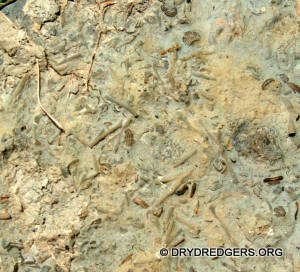
Here's a really nice shale slab covered in the tracks of creepy-crawlies from the late Ordovician Period.
Some of these tracks might be trilobites.
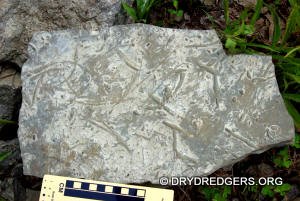
Brachiopods Found That Day
Only modest quantities of the large brachiopod
Vinlandostrophia ponderosa were
found.
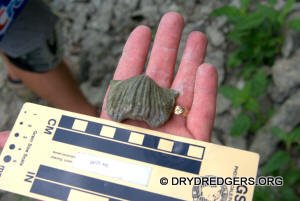


A smaller species of the same brachiopod genera was found in greater numbers.
This one is likely to be Vinlandostrophia laticosta.

Another common brachiopod found in good condition was
Rafinesquina ponderosa.
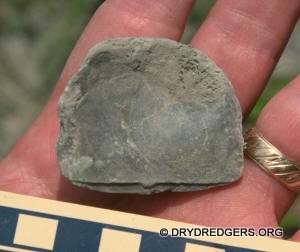
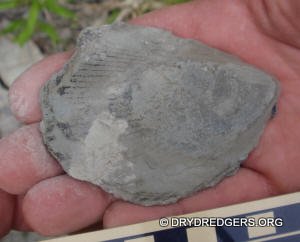
Here are a couple of slabs of rock randomly picked up to show you the abundance
of brachiopods on this fossil site. (next 2 pics)


Nautiloid Cephalopods
In the Corryville and Bellevue formations exposed on this site, orthocone
(straight-shelled) nautiloid
cephalopods are one of the largest fossils. These are the internal
molds of animals with spear-like shells that spanned as long as 14 feet and were
feared by trilobites and others. They are abundant fossils but highly
collectable for obvious reasons.



Here's a close-up of a nautiloid cephalopod specimen with a few chambers
represented as internal molds. Note also that a small tube, called the
Siphuncle, runs down the center or the off-center interior of the chambers.
(next 2 pics)

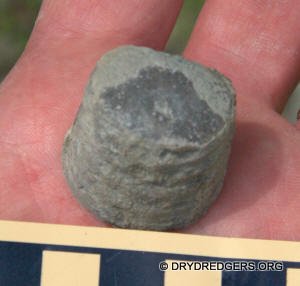
Bryozoans
Here's an interesting ramose (branching) bryozoan. It's still articulated. Many
fossil hunters spend hours gluing fragments of bryozoans together for
exhibition. With this specimen, only a little cleaning is needed. Cool!
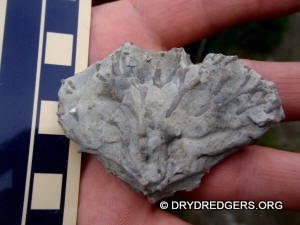
Pelecypods
Among the Pelecypods we saw, also known as bivalves or clams, almost all were
internal molds. The shell of these clams are typically not preserved. Here's a
specimen of what is probably
Ambonychia sp..

Gastropods
One of the snail fossils that had shell details preserved was
Cyclonema sp.

Many of our local fossils are hollow. In the hollowed out portion, water over
time deposits minerals that form calcite crystals, as if the fossil were a
geode. This first picture shows a nice "cathedral" made of calcite. The second
is a brachiopod filled with warmly colored calcite crystals.
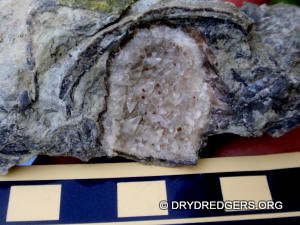
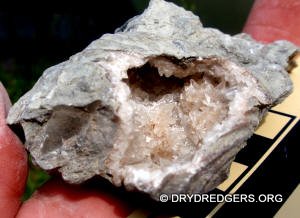
That's all for this field trip. Now lets see
the photo from our September 2017 field trip.
Back to the Field Trip Index Page
Return to Dry Dredgers Home Page
The Dry Dredgers and individual contributors reserve the rights
to all information, images, and content presented here. Permission to reproduce
in any fashion, must be requested in writing to
admin@drydredgers.org.
www.drydredgers.org
is designed and maintained by Bill Heimbrock.



































